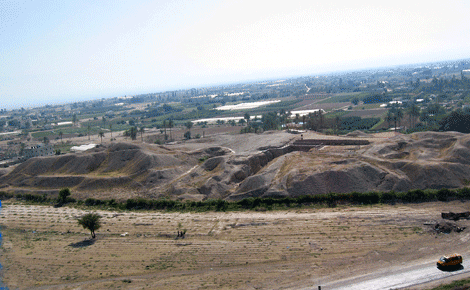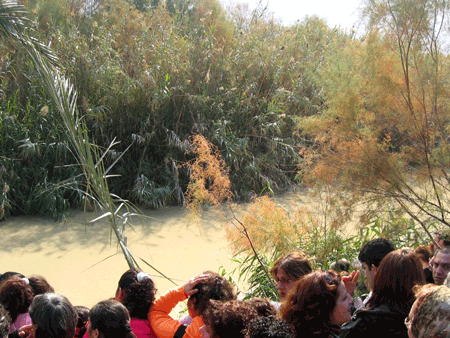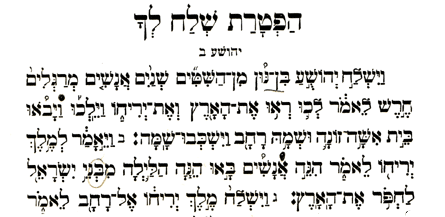|
 |
|
 |
| |
The city
walls fell ages ago, and just recently the
roadblocks have been lifted. We don’t
need a harlot to hide us under some stalks
of flax on her roof so we can safely “view
the land, even Jericho.” (Joshua 2: 1-6)
My favorite part of the Joshua conquest
story is the Israelite march around the
city. Jericho was hermetically sealed.
No one came in and no one went out. We
can imagine the anxiety and even terror of
the residents of this town as they waited
for the Israelites to attack.
They had heard that the God of the
Israelites had dried up the waters of the
Jordan exactly when the children of Israel
were about to cross it. They also
heard how the Israelites had completely
defeated the powerful kings Og and Sihon
east of the River Jordan. |
| |
|
 |
|
Photo:
Gila Yudkin |
|
The mound [or tel] of
ancient Jericho,
looking east |
| |
I’ll bet the
women and children were securely hidden in
the town that first day the Israelites
approached. The Jericho fighters,
waiting for the attack behind the ramparts
of the city wall, might have been quaking in
their sandals. They certainly were
sweating, for it was most likely unbearably
hot at the end of April or early May.
It was a strange army seen by the men of
Jericho peeking over the wall: first
Joshua’s vanguard of armed fighters, but
then seven men in priestly robes blowing
rams’ horns and behind them a box of acacia
wood carried with great reverence. Behind
the Ark, marched the rearguard and then all
the people. There was complete
silence, except for the blowing of the
shofar,
the ram’s horn.
The Jericho fighters must have steeled
themselves, awaiting the attack. Then
came an unexpected move. After the
Israelites had completely circled Jericho
once, they retreated. They returned to
their camp at Gilgal.
The next day, the Jericho fighters, alert
for the attack, would have seen the same
strange procession once again: first the
vanguard, then the priests carrying
shofars, and the Ark of the Covenant
followed by elderly men, women, children and
babies. No talking, nor cheering; no
gossiping, nor sight-seeing. And
they’d never even been to Jericho before.
And certainly, no clicking of cameras or
tweeting. |
| |
|
 |
|
Photo:
Gila Yudkin |
|
View from Tel Jericho
overlooking the "modern" city |
| |
Can you
imagine the discussions the Jericho men and
women would have had in the evening after
the Israelites departed? But as the
surreal march continued day after day, with
no attack, the bewilderment of the Jericho-ites
turned to scorn. I’ll bet that at daybreak
that seventh day, not only were the men up
on the Jericho ramparts, but the women and
children were too, pointing and jeering as
the Israelites approached. Scaredy cats.
This time, on the seventh day, the
Israelites circled the city six times in
utter silence, broken only by the seven
priests blowing their trumpets of rams’
horns. On the seventh time around the
city when the priests blasted those rams’
horns, Joshua commanded the Israelites,
“Shout! For the Lord has given you the
city!” (Joshua 6: 16) And we
know what happened next – those walls “came
a’tumbling down.”
When American journalist
Mark Twain visited Jericho in
1867, he reported, “When Joshua marched
around [Jericho] seven times, some three
thousand years ago, and blew it down with
his trumpet, he did the work so well and so
completely that he hardly left enough of the
city to cast a shadow.” |
| |
To this day,
those walls that came “atumblin’ down” are
nowhere to be seen. For some one hundred
years archeologists -- from Captain Charles
Warren to British Director of Antiquities
John Garstang to Dame Kathleen Kenyon --
searched, but with no success.
There is an ongoing debate about whether the
walls which were unearthed at Jericho are
late 16th or 14th century BC, too early to
have been destroyed by Joshua and the
Israelites. Perhaps the next
generation of archeologists will find and
identify the elusive walls.
Nevertheless, Tel Jericho is definitely
worth a visit. |
| |
|
 |
|
Photo:
Gila Yudkin |
|
Beyond the hump of the
camel on right is Mount Nebo where Moses
died |
| |
| From the
summit of the mound, one has an immediate
grasp of the layout of the land: the
mountains of Moab, the Dead Sea, the Jericho
plain and oases, the wilderness of Judea.
Choose your favorite story: |
| |
- Moses at Mount Nebo looking into the
Promised Land
- Rahab's sheltering of the Israelite
spies
- Joshua at the battle of Jericho
- The ascent of Elijah in a chariot of
fire and a whirlwind
- John baptizing Jesus in the River
Jordan
- The 40-day temptation in the
Wilderness
- Zacchaeus climbing a sycamore tree
|
|
And we have many spirituals to sing!
|
|
|
|
 |
|
Photo:
Gila Yudkin |
|
The Monastery of the
Temptation overlooks the mound of Old Jericho |
| |
|
 |
|
Photo:
Gila Yudkin |
|
Jericho's famous sycamore
tree |
| |
|
 |
|
Photo:
Gila Yudkin |
|
By the bank of the River
Jordan, just east of Jericho |
| |
|
Gila
Yudkin, a Connecticut-born Yankee
living in King David’s Court, loves to spy
out Jericho, particularly in winter.
Gila’s interest in spies and spying began at
age 13 when she chanted Joshua chapter 2 (in
Hebrew!) for her bat mitzvah. |
|
|
|
 |
|
|
|
First two verses of
Joshua 2 from Gila's Bat Mitzvah "Maftir"
booklet |
| |
| Never did
she dream that she would be telling the
Jericho story to thousands of pilgrims, in a
guiding career spanning three decades
(so far!). Along with sharing biblical
insights and archeological anecdotes with
pilgrim groups, Gila loves singing
traditional Negro spirituals. “Joshua
‘fit the battle of Jericho” is one of her
all-time favorites! |
| |
|
Edward Robinson, a
Connecticut Yankee who visited
Jericho in 1838, noted that in the city of
date palms (Deut. 34:3), “only one solitary
date palm lingers in all the plain.”
Edward Robinson possessed an uncanny knack
for accurately identifying lost biblical
sites. |
| |
| Charles
Warren in 1868 missed finding Jericho’s
early Neolithic Tower by only three feet!
It was found nearly 100 years later by
Kathleen Kanyon. But nevertheless,
Charles Warren
does have many archeological exploits to his
credit. |
| |
| For more of
Gila’s spirited comprehensive commentary on
Jericho and Jerusalem, listen to Gila’s
newly-released 60-minute audio CD.
It’s a perfect way to prepare for a Holy
Land tour, or to replay your own experiences
in your car or home. More about
Gila's audio highlights.... |
| |
| Have you
hiked the
old Jericho
Road where there's room for just two, no
more and no less....? |
| |
|
Postscript |
| |
| During the
1980s I spent every Shabbat morning guiding
a walking tour to one of the Quarters of the
Old City. The walking tours were
sponsored by the City of Jerusalem and took
place in the blazing heat as well as in the
freezing snow. I learned much at that
time from my mentor and fellow guide Shira
Nahari. She shared with me many lesser known
engaging stories about the holy city and
demonstrated how to guide with grace
under tough and unpredictable conditions. |
| |
| In response
to this highlight, Shira wrote me the
following: |
|
|
My own favorite understanding of "the
walls came tumbling down" is that the
climax of the psychological warfare you so
aptly describe was a collapse of the
morale of the city's inhabitants making a
conquest relatively easy.
Last year I was privileged to
participate in a guide seminar to Gilgal
and adjacent sites with Adam Zartal, the
head of a 30-year long on-foot survey of
Israelite settlements in the Jordan
Valley. The weather was perfect -
not too hot, not too cold, and slightly
overcast, with a breeze that made the
plague of flies bearable.
|
The team found 200-250 mostly
sandal-shaped settlements, dating from the
time of Joshua and the Judges (i.e.
1250-1000
BCE, as
confirmed by carbon 14 tests on pottery at
the sites). We saw some of these
very, very ancient remains -- quite
exciting the way our guide brought them to
life. One highlight was an hour-long
hike in a wadi [dry riverbed], along which were more
settlements (as in: piles of rocks!)
|
We visited the "real" Gilgal, Joshua's
base camp. It was not an encampment
of dwellings, but rather a ritual center,
with a raised round structure in the
middle that may have been a bamah
or an altar. There was a
processional path around the circumference
of the wall demarcating the boundary of
the encampment. We walked along the
ceremonial path used by the Israelites
when they honored the Mishkan
[Tabernacle] -- THRILLING!
|

